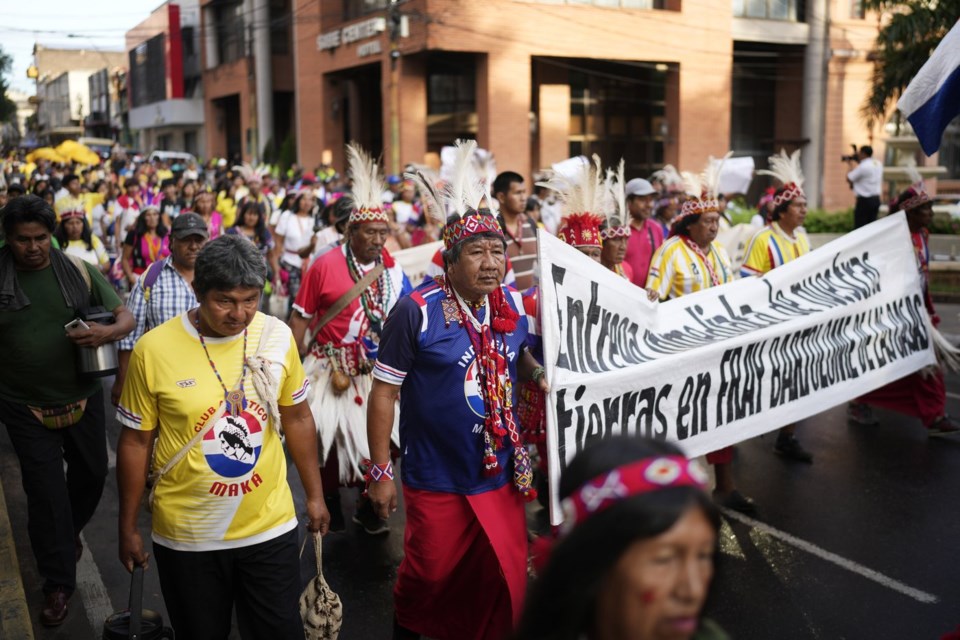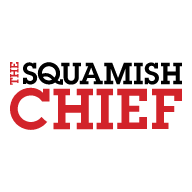ASUNCIÓN, Paraguay (AP) — Many Maká traditions have slowly faded. Yet a few elders among these Paraguayan Indigenous people recall how their songs imitated birds.
“Men used to say that, as they sang, they travelled to Iguazu Falls or to the mountains,” said Gustavo Torres, a Maká teacher based near Paraguay's capital, Asunción. “Their songs imitated nature.”
Next to him smiled Elodia ServĂn, who only speaks the Maká language but had Torres help as a translator. Her skin is covered in wrinkles and she has forgotten her age, but a memory sticks: A long time ago, when she was healthy and strong, she loved dancing in Fray BartolomĂ© de las Casas, a territory her people are now fighting to get back.
The land in dispute is an 828-acre (335 hectare) terrain that the Maká claim ownership over. Paraguay’s government has rejected most of their arguments, designating part of it to build a bridge connecting two cities across the Paraguay River.
Fray BartolomĂ©, as the Maká call it, was offered to them through a decree issued in 1944 by strongman Higinio MorĂnigo, then Paraguay's president. It was meant as a present, the Maká have said, to acknowledge their courage and the role they played during the Chaco War against Bolivia in the 1930s.
“That place is sacred for us,” said Maká leader Mateo MartĂnez, 65. “It was a gift we thanked God for because it was given through people that loved us.”
His ancestors, MartĂnez said, guided soldiers through the mountains and quenched their hunger and thirst during the war.
“Only the Indigenous people knew where to find water,” he said. “If a Paraguayan soldier had gotten lost there alone, he would have died.”
Aside from the decree, details of the gift were never put on paper. The ownership titles were issued in the 2000s, and once they were, less than half of the promised acres were granted to the Maká.
Officials have said that a piece of land was indeed given to the community by MorĂnigo, but its size was never determined nor were its coordinates precise. Both sides meet on a regular basis to discuss a potential new agreement, though no consensus has been reached yet.
“We are open to talking,” MartĂnez said. “But the government won’t listen to us or tries to deceive us.”
The Maká are one of the 19 Indigenous communities of Paraguay. In the South American country of 6.8 million, more than 140,000 are Indigenous people. The latest census from 2022 estimates that around 2,600 Maká are distributed in both urban and rural areas.
Mariano Roque Alonso, where ServĂn and 1,600 other Maká live, is located across the Paraguay River, not too far from Fray BartolomĂ©. Floods forced them to relocate in the 1980s, and they haven’t been able to move back since.
Younger generations have learned Spanish, but their native language remains predominant. A few steps from the Baptist church most of the community attends, the prayers painted on a wall are in Maká.
“Our elders had other beliefs,” MartĂnez said. “They used to believe in the forces of nature. They prayed to the Venus star. To the moon for good health and crops.”
Among their most treasured traditions, the Maká still make a feast when a young woman transitions from puberty to adulthood. Men drink chicha, made of fermented corn, or fight as part of the celebrations. Women like ServĂn sing.
“Our songs come from our ancestors,” she said. “I now want to bequeath them to younger generations. To my daughters and granddaughters.”
Many like her — who sell bags and other embroidered products — make a living from craftsmanship.
Patricio Colman, 63, produces necklaces, bracelets, arrows and bows. He, too, grew up in Fray Bartolomé and recalls his people’s long-gone traditions.
“When hunters were still alive, they gathered to go hunting and stayed up to three months in the mountains,” Colman said. “But no one does that anymore.”
Back in the day, he said, the Maká had various leaders. One for hunting, one for fishing, one for youth and one for dancing. Now MartĂnez is the only one left.
“Even then, when officials used to visit, the distribution of the territory was unclear,” Colman said. “There had always been a threat of invasion.”
The Maká not only weep for the loss of the land itself, but the distance keeping them from their loved ones buried in Fray BartolomĂ©. Among them is Juan Belaieff, a Russian soldier and cartographer who mapped the region during the Chaco War. According to MartĂnez, then-elders thought of him as a white deity who served as a link between the community and God.
“They loved him deeply, and he was venerated by our grandparents,” the leader said.
Non-Maká people might find it hard to spot their cemetery. With no tombstones or crosses on-site, officials have doubted their claims.
“We are a different culture, though,” MartĂnez said. “When a Maká perishes, we don’t use a cross.”
The community does dig graves for loved ones who have recently died. Relatives cover the bodies with a cloak and the person’s belongings, but no other rituals are performed and graves are not marked.
“Relatives feel the absence so profoundly that we don’t do any ceremonies or console each other,” MartĂnez said. “It’s a moment of respect.”
The Maká now bury their people in Quemkuket, about 11 miles (18 kilometers) from their current settlement, but they hope to eventually get their ancestors’ remains back in one place.
“The Maká are warriors, courageous warriors,” MartĂnez said. “We have been fighting for this for five or six years and have no intention of ever giving up.”
____
Associated Press religion coverage receives support through the AP’s with The Conversation US, with funding from Lilly Endowment Inc. The AP is solely responsible for this content.
MarĂa Teresa Hernández, The Associated Press




